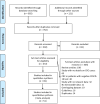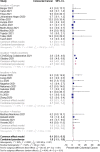Colorectal cancer in patients with SARS-CoV-2: a systematic review and meta-analysis
- PMID: 36096812
- PMCID: PMC9466313
- DOI: 10.1186/s13027-022-00459-7
Colorectal cancer in patients with SARS-CoV-2: a systematic review and meta-analysis
Abstract
Background: Patients with colorectal cancer (CRC) are more likely to develop severe course of severe acute respiratory syndrome coronavirus 2 (SARS-CoV-2) infection and experience increased risk of mortality compared to SARS-CoV-2 patients without CRC.
Objectives: To estimate the prevalence of SARS-CoV-2 infection in CRC patients and analyse the demographic parameters, clinical characteristics and treatment outcomes in CRC patients with COVID-19 illness.
Methods: For this systematic review and meta-analysis, we searched Proquest, Medline, Embase, Pubmed, CINAHL, Wiley online library, Scopus and Nature for studies on the incidence of SARS-CoV-2 infection in CRC patients, published from December 1, 2019 to December 31, 2021, with English language restriction. Effect sizes of prevalence were pooled with 95% confidence intervals (CIs). Sub-group analyses were performed to minimize heterogeneity. Binary logistic regression model was used to explore the effect of various demographic and clinical characteristics on patient's final treatment outcome (survival or death).
Results: Of the 472 papers that were identified, 69 articles were included in the systematic review and meta-analysis (41 cohort, 16 case-report, 9 case-series, 2 cross-sectional, and 1 case-control studies). Studies involving 3362 CRC patients with confirmed SARS-CoV-2 (all patients were adults) were analyzed. The overall pooled proportions of CRC patients who had laboratory-confirmed community-acquired and hospital-acquired SARS-CoV-2 infections were 8.1% (95% CI 6.1 to 10.1, n = 1308, 24 studies, I2 98%, p = 0.66), and 1.5% (95% CI 1.1 to 1.9, n = 472, 27 studies, I2 94%, p < 0.01). The median patient age ranged from 51.6 years to 80 years across studies. The majority of the patients were male (n = 2243, 66.7%) and belonged to White (Caucasian) (n = 262, 7.8%), Hispanic (n = 156, 4.6%) and Asian (n = 153, 4.4%) ethnicity. The main source of SARS-CoV-2 infection in CRC patients was community-acquired (n = 2882, 85.7%; p = 0.014). Most of those SARS-CoV-2 patients had stage III CRC (n = 725, 21.6%; p = 0.036) and were treated mainly with surgical resections (n = 304, 9%) and chemotherapies (n = 187, 5.6%), p = 0.008. The odd ratios of death were significantly high in patients with old age (≥ 60 years) (OR 1.96, 95% CI 0.94-0.96; p < 0.001), male gender (OR 1.44, 95% CI 0.41-0.47; p < 0.001) CRC stage III (OR 1.54, 95% CI 0.02-1.05; p = 0.041), CRC stage IV (OR 1.69, 95% CI 0.17-1.2; p = 0.009), recent active treatment with chemotherapies (OR 1.35, 95% CI 0.5-0.66; p = 0.023) or surgical resections (OR 1.4, 95% CI 0.8-0.73; p = 0.016) and admission to ICU (OR 1.88, 95% CI 0.85-1.12; p < 0.001) compared to those who survived.
Conclusion: SARS-CoV-2 infection in CRC patient is not uncommon and results in a mortality rate of 26.2%. Key determinants that lead to increased mortality in CRC patients infected with COVID-19 include older age (≥ 60 years old); male gender; Asian and Hispanic ethnicity; if SARS-CoV-2 was acquired from hospital source; advanced CRC (stage III and IV); if patient received chemotherapies or surgical treatment; and if patient was admitted to ICU, ventilated or experienced ARDS.
Keywords: COVID-19; Cancer; Colon; Colorectal; Meta-analysis; Rectum; SARS-Cov-2; Systematic review.
© 2022. The Author(s).
Conflict of interest statement
The authors declare that they have no competing interests.
Figures









References
-
- World Health Organization. WHO coronavirus disease (COVID-19) dashboard 2022 [21 July 2022]. Available from: https://covid19.who.int/.
-
- Centers for disease control and prevention. Risk for COVID-19 infection, hospitalization, and death by age group 2022 [21 July 2022]. Available from: https://www.cdc.gov/coronavirus/2019-ncov/covid-data/investigations-disc....
-
- Centers for disease control and prevention. Underlying medical conditions associated with high risk for severe COVID-19: Information for healthcare providers 2022 [21 July 2022]. Available from: https://www.cdc.gov/coronavirus/2019-ncov/hcp/clinical-care/underlyingco.... - PubMed
-
- Centers for Disease Control and Prevention. Science brief: Evidence used to update the list of underlying medical conditions that increase a person's risk of severe illness from COVID-19 2022 [21 July 2022]. Available from: https://www.cdc.gov/coronavirus/2019-ncov/science/science-briefs/underly.... - PubMed
-
- Sorensen RJ, Barber RM, Pigott DM, Carter A, Spencer CN, Ostroff SM, Reiner RC, Jr, Abbafati C, Adolph C, Allorant A. Variation in the COVID-19 infection-fatality ratio by age, time, and geography during the pre-vaccine era: A systematic analysis. Lancet. 2022;399(10334):1469–1488. doi: 10.1016/S0140-6736(21)02867-1. - DOI - PMC - PubMed
LinkOut - more resources
Full Text Sources
Miscellaneous

